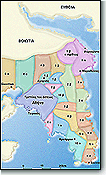






      |
|
|
|
The trittys was one third of the tribe. Consequently there were twelve trittyes, corrsponding to the four tribes. After the reforms of 507 B.C. there were thirty trittyes for the |  |
The heads of the trittyes were the trittyarchoi. They were responsible for road works; for constructing walls and ships; and for matters concerning recruiting. They probably also took on the role of celebrant of the ritual in certain cults, as a sacrifice by the name of trittys is recorded. The connection between the trittys and cult duties is also apparent from the single trittys name we possess, 'Leukotainioi', meaning "those who wear a white ribbon", and it denotes a trittys of the Geleontes tribe.
|
|
| |
|
Note: Click on a picture for a brief description. | |